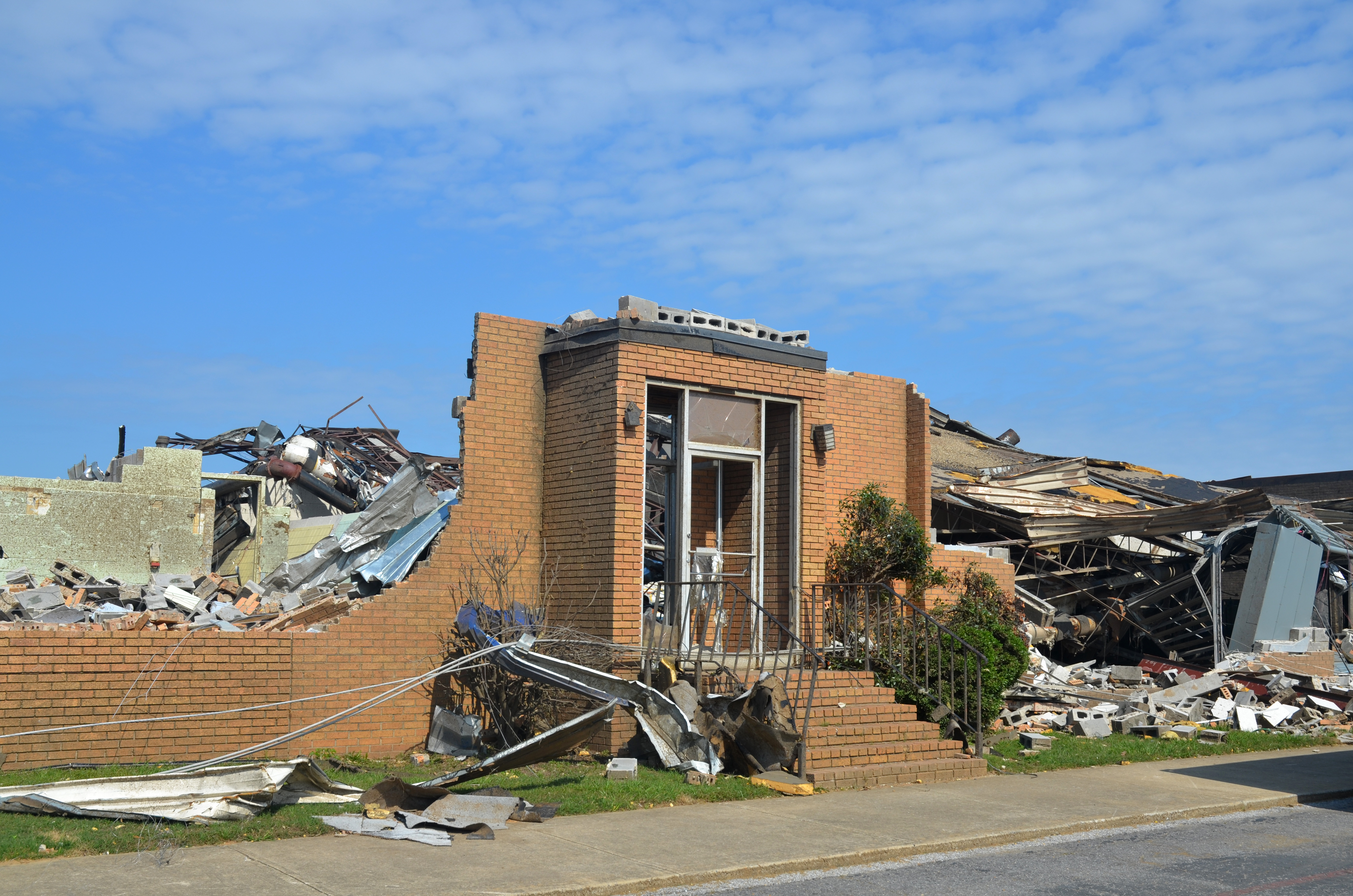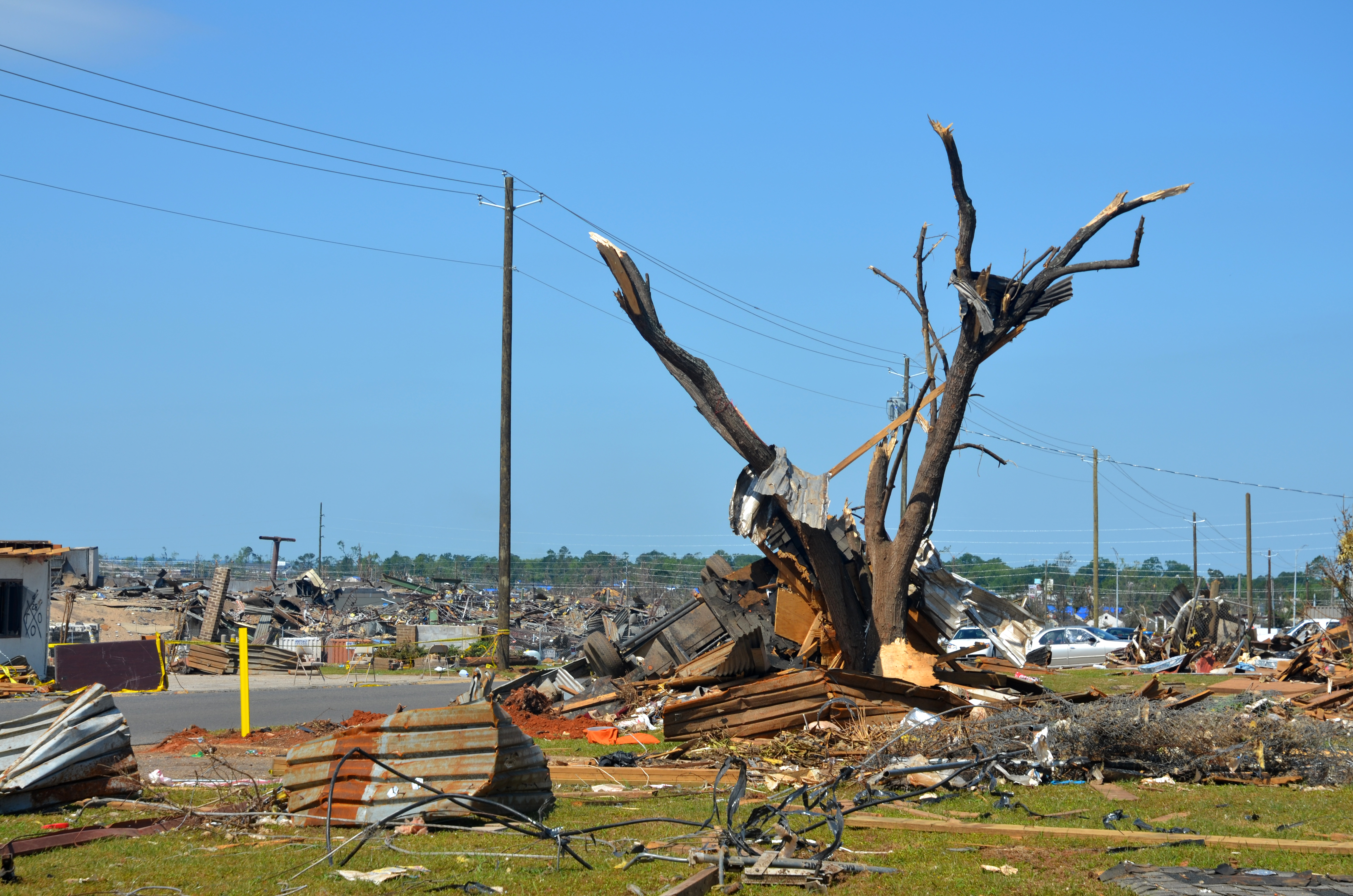Mother Nature may be unpredictable but she doesn't discriminate. When hurricanes come ashore, tornadoes touch down, or wildfires spread, everything in their paths face the indiscriminant force of nature.
On April 27, 2011, devastation from 30 confirmed tornadoes in northeast Alabama was "beyond unprecedented; it was epic," according to the Alabama League of Municipalities. The EF-4 tornado that touched down in Tuscaloosa "pulverized a 5.9-mile long, 1.5-mile wide area, rendering thousands homeless, killing 41, injuring hundreds and destroying more than 5,000 structures including the city's Curry Building, which housed its emergency management agency and environmental services division." according to the Alabama League.


More than 5,000 structures in Tuscaloosa were either severely damaged or destroyed by 30 confirmed tornadoes in northeast Alabama on April 27, 2011.
(Photo: Alabama League of Municipalities)
Alabama Mayors Ken Sunseri of Haleyville and Walt Maddox of Tuscaloosa addressed the 2012 Alabama League's Annual Meeting. They shared with their peers "things I know now that I wish I had known then."
Preplanning is critical
According to Mayor Sunseri, Haleyville found itself dealing with unanticipated and unique events immediately following the April 27 tornadoes, such as providing support for neighboring Hackleburg, Phil Campbell and East Franklin; transporting supplies along the tornado route; and coordinating the Armed Forces Reserve Center for Alabama Power work crews.
Sunseri stressed that to prepare for an emergency, all municipalities should immediately
evaluate their assets (buildings, equipment, personnel);
preplan emergency requirements with the county EMA; and
identify critical areas such as hospitals, schools, recreational facilities, nursing homes, day care and senior centers, water plants, sewer plants and churches.
In addition, Sunseri said backup communications (ham radios), emergency ordinances, an operations plan and offsite information technology backup are crucial following a natural disaster. He stressed that if your area is affected to expect loss of communications; damage to structures; gas leaks; loss of traffic signals; store closures; and disruption of utilities, travel, medical care and fuel/food supplies as well as dependence on emergency supplies and volunteers. Security, shelter, power, drinking water, food, medications and ice are imperative.
Develop a media plan
Mayor Maddox stressed the importance of having a media component built into a municipal disaster management plan. He said for about four days following the April 27 tornadoes, Tuscaloosa became the news story of the day, receiving media attention from around the world. And while he only granted about 20 percent of the national media interview requests, he said it is very important to maintain a good relationship with the local media.
Maddox told attendees he didn't turn down any interviews from local media and always gave the updated numbers and information to the local media first. "The local media are there and will be with you throughout," he said.
"Don't be mesmerized by the national media superstars because they-re going to immediately move on to the next story. Your local media, however, isn't going anywhere. And so we made an effort to work very closely with our local outlets."
Maddox also stressed having one media spokesperson and to offer short, concise answers. "In a disaster, you don't want multiple people speaking for your city," he said. "You need one spokesperson who can speak for the entire city."
FEMA recommends the mayor serve as spokesperson for the municipality and Maddox agrees. "The chief executive officer needs to be the one explaining to the citizens where you are in the process," he said. "Always remain calm and hopeful during your media interviews. This is not only important for your citizens, it's important for your staff as well."
Maddox said a municipality's media plan should: stay local; be calm and hopeful; be honest and transparent; express your need; be visible; utilize social media; and have one spokesperson. He stressed that social media must be included in the plan because that's where people will look first, especially when there's no power.
"It doesn't matter the size of your city, social media is how people now communicate," Maddox said. "When the power is out, there's no television, but cell phones are going to continue to work."
Following the tornadoes on April 27, Maddox said, "Every one of Tuscaloosa's humanitarian aid stations provided chargers for a variety of cell phones as well as Wi-Fi and laptops - people could come in and register at FEMA.gov for their benefits. People knew what was going on by their Twitter and Facebook accounts. In fact, in Tuscaloosa, we took tweets and bounced them off electronic billboards to amplify the effect."
Be prepared for unique challenges
Maddox went on to say that every recovery will be different and have unique challenges. Following the April 27 tornadoes, 61 percent of the impacted homes in Tuscaloosa were rentals with a median household income of less than $28,000. "We were very blessed in Tuscaloosa because, of the 7,000 people who were displaced, there was enough available housing in the city for the people to fall into," Maddox said. However, while that was good for humanitarian efforts, it was bad for recovery. Rebuilding was minimal since there was no housing market to build back to.
Tuscaloosa has also had zoning challenges. "Of the 300-plus businesses affected, 111 were built before 1969," Maddox said. "1972 is a line of demarcation in the city because that's when we implemented zoning ordinances, and so all 111 businesses, maybe even more, cannot build back under any circumstances. It's not just an issue of allowing mobile homes to go back again on property; are you going to allow businesses that are nonconforming to build back? Those are difficult decisions that you-ll face in recovery."
He also encouraged attendees to determine where the floodways are in their communities and to make sure their mapping is current. "Tuscaloosa should have been remapping more floodways before April 27," he said. "A large floodway bisects the tornado path in Tuscaloosa, and we now have dozens of businesses and homes that are waiting for FEMA to approve the new floodway map revisions so they can build back."
In closing, Maddox reminded attendees that there is minimal funding from the state and federal government to help during recovery and that if you face a disaster, the rebuilding is going to be mostly on your own. "In Joplin, Missouri, they-ve been blessed that the state has been able to provide them with tens of millions of dollars to go towards their recovery," Maddox said. "Their state government right now is in pretty good shape and the City of Joplin was the only city affected."
However, with more than 40 Alabama counties presidentially declared as disasters following the April 27, 2011, tornado outbreak, Alabama Governor Bentley didn't have that luxury. Maddox also stressed significant shortfalls in federal aid.
"Only $400 million was appropriated in 2011 to go nationwide to all the cities that were presidentially-declared disasters," he said. "The state of Alabama got $55 million. Juxtapose that with the state of Mississippi, which received $5.4 billion after Katrina for recovery. The damage on April 27 in Alabama was substantially worse than the damage in Mississippi during Katrina. The city of Tuscaloosa has $200 million in unmet needs, and we received $16.6 million. It will, indeed, continue to be a significant challenge."
The remarks from Mayors Sunseri and Maddox are reprinted with permission from the Alabama Municipal Journal, July 2012.
